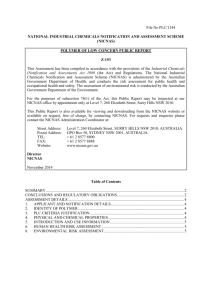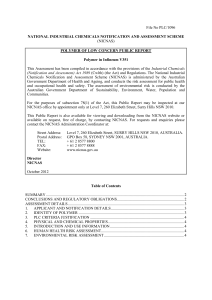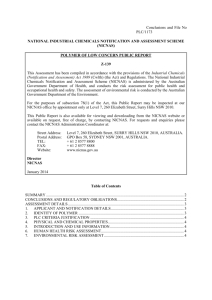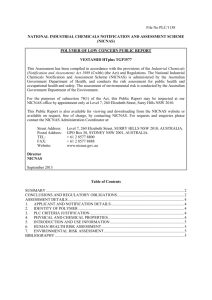PLC/1129
advertisement
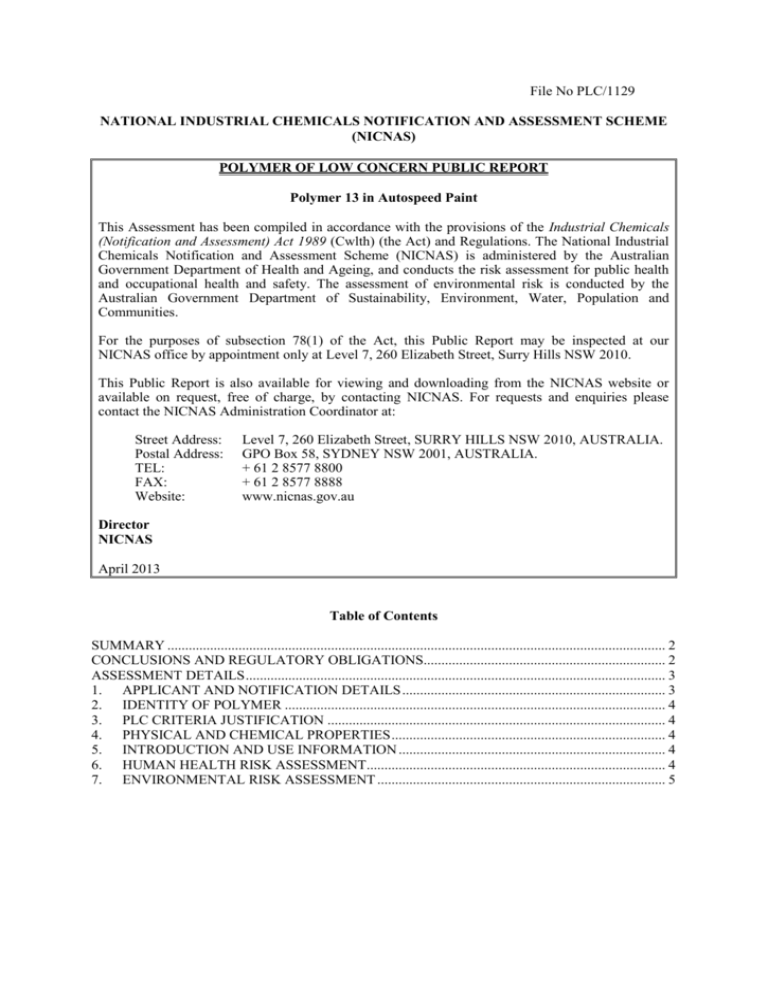
File No PLC/1129 NATIONAL INDUSTRIAL CHEMICALS NOTIFICATION AND ASSESSMENT SCHEME (NICNAS) POLYMER OF LOW CONCERN PUBLIC REPORT Polymer 13 in Autospeed Paint This Assessment has been compiled in accordance with the provisions of the Industrial Chemicals (Notification and Assessment) Act 1989 (Cwlth) (the Act) and Regulations. The National Industrial Chemicals Notification and Assessment Scheme (NICNAS) is administered by the Australian Government Department of Health and Ageing, and conducts the risk assessment for public health and occupational health and safety. The assessment of environmental risk is conducted by the Australian Government Department of Sustainability, Environment, Water, Population and Communities. For the purposes of subsection 78(1) of the Act, this Public Report may be inspected at our NICNAS office by appointment only at Level 7, 260 Elizabeth Street, Surry Hills NSW 2010. This Public Report is also available for viewing and downloading from the NICNAS website or available on request, free of charge, by contacting NICNAS. For requests and enquiries please contact the NICNAS Administration Coordinator at: Street Address: Postal Address: TEL: FAX: Website: Level 7, 260 Elizabeth Street, SURRY HILLS NSW 2010, AUSTRALIA. GPO Box 58, SYDNEY NSW 2001, AUSTRALIA. + 61 2 8577 8800 + 61 2 8577 8888 www.nicnas.gov.au Director NICNAS April 2013 Table of Contents SUMMARY ............................................................................................................................................ 2 CONCLUSIONS AND REGULATORY OBLIGATIONS.................................................................... 2 ASSESSMENT DETAILS ...................................................................................................................... 3 1. APPLICANT AND NOTIFICATION DETAILS .......................................................................... 3 2. IDENTITY OF POLYMER ........................................................................................................... 4 3. PLC CRITERIA JUSTIFICATION ............................................................................................... 4 4. PHYSICAL AND CHEMICAL PROPERTIES ............................................................................. 4 5. INTRODUCTION AND USE INFORMATION ........................................................................... 4 6. HUMAN HEALTH RISK ASSESSMENT.................................................................................... 4 7. ENVIRONMENTAL RISK ASSESSMENT ................................................................................. 5 April 2013 NICNAS SUMMARY The following details will be published in the NICNAS Chemical Gazette: ASSESSMENT APPLICANT(S) REFERENCE PLC/1129 Dulux Group Limited CHEMICAL OR HAZARDOUS INTRODUCTION TRADE NAME SUBSTANCE VOLUME Polymer 13 in Autospeed Paint No < 10 tonnes per annum USE A component of automotive paints CONCLUSIONS AND REGULATORY OBLIGATIONS Human Health Risk Assessment Based on the assumed low hazard and the assessed use pattern, the notified polymer is not considered to pose an unreasonable risk to the health of workers and the public, provided that appropriate PPE is used by workers during spray application. Environmental Risk Assessment Based on the assumed low hazard and the assessed use pattern, the notified polymer is not considered to pose an unreasonable risk to the environment. Health and Safety Recommendations Employers should ensure that the following personal protective equipment is used by workers to minimise occupational exposure to the notified polymer: Respiratory protection during spray applications Guidance in selection of personal protective equipment can be obtained from Australian, Australian/New Zealand or other approved standards. A copy of the MSDS should be easily accessible to employees. Spray applications should be carried out in accordance with the Safe Work Australia Code of Practice for Spray Painting and Powder Coating (Safe Work Australia, 2012) or relevant State or Territory Code of Practice. If products and mixtures containing the notified polymer are classified as hazardous to health in accordance with the Globally Harmonised System for the Classification and Labelling of Chemicals (GHS), as adopted for industrial chemicals in Australia, workplace practices and control procedures consistent with provisions of State and Territory hazardous substances legislation should be in operation. Environmental Recommendations No specific control measures are required to minimise release of the notified polymer to the environment. Disposal The notified polymer should be disposed to landfill. Storage The following precautions should be taken by workers regarding storage of the notified polymer: FULL PUBLIC REPORT: PLC/1129 Page 2 of 5 April 2013 − − NICNAS Store in a segregated and approved area. Store in original container protected from direct sunlight in a dry, cool and well-ventilated area, away from incompatible materials (oxidising substances, strong acids, strong bases). Emergency Procedures Spills and/or accidental release of the notified polymer should be handled by physical containment, collection and subsequent safe disposal. Secondary Notification This risk assessment is based on the information available at the time of notification. The Director may call for the reassessment of the polymer under secondary notification provisions based on changes in certain circumstances. Under Section 64 of the Industrial Chemicals (Notification and Assessment) Act (1989) the notifier, as well as any other importer or manufacturer of the notified polymer, have post-assessment regulatory obligations to notify NICNAS when any of these circumstances change. These obligations apply even when the notified polymer is listed on the Australian Inventory of Chemical Substances (AICS). Therefore, the Director of NICNAS must be notified in writing within 28 days by the notifier, other importer or manufacturer: (1) Under Section 64(1) of the Act; if the notified polymer is introduced in a chemical form that does not meet the PLC criteria. or (2) Under Section 64(2) of the Act; if the function or use of the notified polymer has changed from a component of automotive paints, or is likely to change significantly; the amount of notified polymer being introduced has increased, or is likely to increase, significantly; the notified polymer has begun to be manufactured in Australia; additional information has become available to the person as to an adverse effect of the notified polymer on occupational health and safety, public health, or the environment. The Director will then decide whether a reassessment (i.e. a secondary notification and assessment) is required. Material Safety Data Sheet The MSDS of the notified polymer was provided by the applicant. The accuracy of the information on the MSDS remains the responsibility of the applicant. ASSESSMENT DETAILS 1. APPLICANT AND NOTIFICATION DETAILS Applicant DuluxGroup (Australia) Pty Ltd ( ABN: 67 000 049 427) 1956 Dandenong Road CLAYTON VIC 3168 Exempt Information (Section 75 of the Act) Data items and details claimed exempt from publication: chemical name, CAS number, molecular and structural formulae, molecular weight, spectral data, polymer constituents, residual monomers/impurities, and import volume. PUBLIC REPORT: PLC/1129 Page 3 of 5 April 2013 NICNAS 2. IDENTITY OF POLYMER Marketing Name(s) Polymer 13 in Autospeed Paint 3. PLC CRITERIA JUSTIFICATION Criterion Molecular Weight Requirements Functional Group Equivalent Weight (FGEW) Requirements Low Charge Density Approved Elements Only Stable Under Normal Conditions of Use Not Water Absorbing Not a Hazard Substance or Dangerous Good Criterion met Yes Not applicable Yes Yes Yes Yes Yes The notified polymer meets the PLC criteria. 4. PHYSICAL AND CHEMICAL PROPERTIES Appearance at 20 °C and 101.3 kPa Melting Point/Glass Transition Temp Density Water Solubility Dissociation Constant Reactivity Degradation Products Clear solid resin 36 °C 1,099 kg/m3 at 20 °C Not determined. Expected to be low based on the predominantly hydrophobic structure of the notified polymer. Not determined. Notified polymer contains dissociable functionalities. However, it is not expected to be significantly ionised under environmental conditions due to its low solubility. Stable under normal environmental conditions None under normal conditions of use 5. INTRODUCTION AND USE INFORMATION Maximum Introduction Volume of Notified Chemical (100%) Over Next 5 Years Year Tonnes 1 < 10 2 < 10 3 < 10 4 < 10 5 < 10 Use The notified polymer will not be manufactured in Australia. The notified polymer will be imported into Australia as a component of finished automotive paints at < 10% concentration and will only be used by professional spray painters. 6. HUMAN HEALTH RISK ASSESSMENT The finished automotive paints containing the notified polymer will be applied by spray in ventilated spray booths by professional painters only using protective equipment; hence the potential for exposure should be limited. Furthermore, the notified polymer has a molecular weight of < 10,000 Da; hence lung overloading effects are not expected if inhalation exposure were to occur. Based on the assumed low hazard of the notified polymer and occupational settings described, the risk to workers from use of the notified polymer is not considered unreasonable. PUBLIC REPORT: PLC/1129 Page 4 of 5 April 2013 NICNAS 7. ENVIRONMENTAL RISK ASSESSMENT No ecotoxicological data were submitted. Polymers without significant ionic functionality are of low concern to the aquatic environment. Up to 1% of the total import quantity of notified polymer is estimated to be released to the environment as a result of accidental spills and leaks during shipping, transport, and warehousing. Spills and leaks are expected to be collected with absorbent material and disposed of in accordance with State/Territory regulations. The main release (up to 50%) may occur from overspray, mixing of chemicals, equipment cleaning during use and loss from residues in the containers. These wastes are expected to be disposed of to landfill. Discarded end use articles containing the notified polymer within the cured paint film will be disposed to landfill, or recycled for metals reclamation which will entail thermal decomposition of the paint to form oxides of carbon and water vapour. In landfill, the notified polymer will be present as a cured solid film and will be neither bioavailable nor mobile. It will slowly degrade in landfill by biotic and abiotic processes. Therefore based on the low assumed hazard to aquatic organisms and low potential for aquatic exposure, the notified polymer is not expected to pose an unreasonable risk to the environment when it is used as proposed. PUBLIC REPORT: PLC/1129 Page 5 of 5



